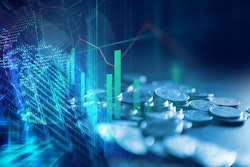
Data has increasingly become a primary commodity of modern business — and the supply chain industry is no different. Companies now utilize developing technological resources to increase visibility at every level, providing unprecedented degrees of clarity. The amount of data available to businesses today is simply staggering; however, data itself is not intrinsically valuable. Unlike capital, data can only provide value when accurately and comprehensively analyzed. The insights taken from that analysis are what lead to growth and profits.
Technology has been increasing visibility over the past decade; however, the downside to this improvement is that data sets become too large and complicated for employees to possibly grasp. Humans alone cannot reasonably be expected to generate useful insights from so many data points. Instead, businesses may turn to artificial intelligence (AI) to manage the load. Predictive analytics are the key to unlocking a company’s true potential and will shortly become the standard by which businesses are able to keep ahead of the digital revolution.
For many companies, the Internet of Things (IoT) is a blessing and a curse. While the ability of individual devices to constantly and instantaneously upload billions of data points to a central processor provides previously unheard of analytical potential, businesses can become completely overwhelmed by the sheer amount of information. If data is the new currency, quality over quantity is more important than ever and many companies will turn to predictive analytics.
Demand Sensing
The ability to turn a massive quantity of data into quality insights is the key to getting in front of the curve. One way that this new technology accomplishes such a high level of insight is through demand sensing. Now, businesses can not only bring in geographical and sales data points to see how many orders their customers are making and from where, but by using self-learning algorithms, they can actually get ahead of the game. Predictive analytics can let shippers know when and where their products will be most in demand before that demand actually hits, thus ensuring there is no shortage in supplies and thereby maximizing profits. If something does go wrong along the way, machine-learning algorithms can automatically identify potential exceptions and alert customers beforehand, giving them time to be proactive.
Route Mapping
Another area in which artificial intelligence is invaluable is route mapping. Analyzing real-time location data, such as road closures and traffic updates, along with utilizing delivery optimization algorithms, drivers can now receive updates as to the quickest and most efficient delivery schedules. This not only allows customers to receive their shipments faster, but it saves businesses time and money in the process.
Facilities Selection
Finally, predictive analytics can be used to forecast possible outcomes in facilities selection, ensuring the highest possible profit margin. Delivering products efficiently starts with strategically-placed distribution centers that can meet demand once it is recognized. Whether opening new facilities or redesigning current organizational structures, predictive analytics can take warehouse metrics such as rent and labor costs, and factor in geographical and sales data to forecast the most profitable locations available.
This list is not exhaustive. By the time you read this, artificial intelligence systems may have already developed other ways to optimize operations not mentioned here. The first step for companies that want to stay relevant in the supply chain industry is to properly harness the overabundance of data available to them and embrace predictive analytics as the tools of the future. Leaders in the marketplace will distinguish themselves and their businesses by making informed and insightful decisions before the need arises. Putting out fires is simply not going to cut it in the coming years. Big data is about collecting information from the past, but the big picture is using that data to take control of the future.




















![Pros To Know 2026 [color]](https://img.sdcexec.com/mindful/acbm/workspaces/default/uploads/2025/08/prostoknow-2026-color.mduFvhpgMk.png?ar=16%3A9&auto=format%2Ccompress&bg=fff&fill-color=fff&fit=fill&h=135&q=70&w=240)